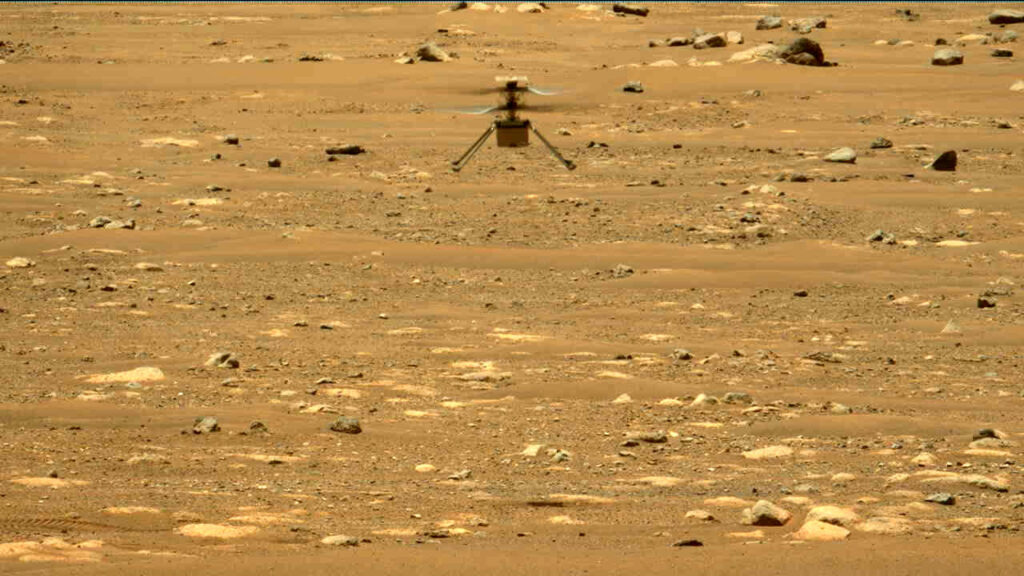
Mastcam-Z is a pair of cameras located high on the rover’s mast.
This is one still frame from a sequence captured by the camera while taking video.
This image was acquired on Apr. 22, 2021. Credit: NASA/JPL-Caltech/ASU/MSSS
A small, solar-powered helicopter has made history by becoming the first aircraft from Earth to
fly on another planet.
Ingenuity is the drone-sized helicopter that hitched a ride on the most recent Mars rover mission.
See TKN’s article, Perseverance Rover Starts Two-Year Mission on Mars
It measures about half a metre in height, and weighs about 1.8 kilograms.
On April 19, Ingenuity rose three metres into the air and hovered briefly before landing
again. Although it was a very short flight—only about 39 seconds—it was important because it
demonstrated for the first time that aircraft could fly in Mars’ atmosphere.
The atmosphere surrounding Mars is much thinner than Earth’s atmosphere. That makes flying
more difficult, because an aircraft’s rotors or wings need to push against the air in order to lift
the aircraft off the ground.
To help lift Ingenuity off Mars’ surface, NASA engineers built it out of very light materials.
They also gave it two rotors (the blades at the top of the helicopter) that were more than a metre
wide and spun very quickly in opposite directions.
Ingenuity has now flown four times on Mars. On its fourth and longest flight, on April 30, it
stayed in the air for nearly two minutes, and travelled a total of 266 metres—about the length of
four and a half ice hockey rinks or three American football fields.
During its flight, it took more than 60 photographs.
The flights were guided by mission controllers at NASA’s Jet Propulsion Laboratory in
California. They sent commands to the Perseverance rover, which relayed them to Ingenuity and
also filmed the helicopter’s flights.
Helicopters like Ingenuity could be important for future exploration on Mars and other planets.
They can photograph the surface and help plan the best routes for rovers to take. They can also
help scientists study areas that would be difficult or impossible for a rover to reach, such as cliffs.
NASA scientists compared Ingenuity’s first flight to the first controlled flight of an airplane on
Earth, by Orville and Wilbur Wright, in 1903. A piece of fabric about the size of a postage stamp
was taken from the Wright brothers’ airplane and attached to one of Ingenuity’s solar panels as a
tribute to them.
Ingenuity was originally supposed to complete five flights, but NASA has announced that it will probably carry out two or three additional flights before the end of May. After that, NASA will focus on the Perseverance rover and its mission.
THINK AND DISCUSS
What does the word “ingenuity” mean? Is it appropriate for the name of the helicopter? Why or why not?
What do you know about Mars?
Where is Mars in our solar system, compared to the other planets?
Can you draw Mars? What colours would you need–and why?
In this article, the author compares 266 metres to the length of ice rinks and American football fields. What other things are about 266 metres (long, wide or tall)?
A piece of fabric from the Wright brothers’ plane was attached to Ingenuity. Why do you think they did that? It is very important that Ingenuity be as light as possible–do you think they should have included the fabric or not? Explain.
Compare a helicopter to a plane. How are they different? In what ways are they similar?
Are there any words in this article that you did not know before you read it? List them and say what you think they mean, from the way they’re used in the article. Now look them up to find the dictionary’s definitions. Do they mean what you thought they did?
LINKS
Ingenuity’s first flight (filmed by Perseverance rover)
Make a paper Mars helicopter This terrific activity by NASA gives you everything you need to create a paper helicopter including video instructions and a template you can download.
What is aerodynamics? (NASA website)







